DACF Home → Bureaus & Programs → Maine Forest Service → Forest Health & Monitoring → Invasive Threats to Maine's Forests and Tree → Browntail Moth Euproctis chrysorrhoea
Browntail Moth - Euproctis chrysorrhoea (L.)

On this Page:
- FAQs
- News & Events
- Browntail Moth Mitigation Fund
- General Information
- Management Techniques
- Where is Browntail Moth?
- For Towns & Businesses
- Research
Frequently Asked Questions
Partners at Maine Forest Service, Maine Board of Pesticides Control, Maine Center for Disease Control, Cooperative Extension and others have put together an extensive list of frequently asked questions. Questions cover topics from biology, to management, to policy to pets.
When will the caterpillars be active? +
- The caterpillars are active at two times of the year. In mid-April, they emerge from their winter webs and begin feeding and growing until they reach their maximum size in June.
- The second batch of caterpillars hatch from their eggs in August and are active until early October when they enter their winter webs to hibernate, emerging the following spring.
Close -
What time of year should I clip overwintering webs? +
- The Maine Forest Service recommends clipping webs between October and mid-April before caterpillars emerge from winter webs and begin feeding on new leaves.
- This task is more easily accomplished after the leaves have fallen from the trees as the webs are more visible.
- Web removal after mid-April when the caterpillars have emerged is not recommended as it is less effective and pruning wounds can be more damaging to trees and shrubs at this time of year.
Close -
How do I avoid exposure to the browntail moth toxic hairs? +
- When working in heavily infested areas, wear proper protective equipment to reduce exposure including:
- Long sleeves
- Long pants
- Goggles
- Dust mask/respirator
- Hat
- Disposable coveralls
- Avoid heavily infested areas between April and August, don't use leaf blowers or lawnmowers on dry days in these areas
- Using pre-contact poison ivy wipes can help minimize hairs sticking into exposed skin
- Do yardwork on wet days, which decreases the likelihood that the hairs will become airborne.
- Make sure to use a HEPA filter on a wet/dry vacuum to decrease the likelihood that the hairs will become airborne.
- Do not dry laundry outside in infested areas.
Close -
How do I manage browntail moth webs in tall trees? +
- Some libraries have sets of pole pruners for loan. You may also be able to rent pole pruners.
- With care, a stable ladder, such as an orchard ladder or a lift can help in access to higher webs
- Some trees are too big to practically manage through web clipping, even by professional arborists. Properly applied insecticides can work for population reduction in these trees.
- The Maine Forest Service maintains a list of licensed arborists providing pruning services that can be found at www.maine.gov/dacf/mfs/forest_health/invasive_threats/browntail_moth_info.htm.
Close -
When is the greatest risk of getting the rash? +
- The greatest risk for exposure to the toxic hairs is between April and July.
- Caterpillars, shed skins, and cocoons all have toxic hairs.
- The toxin is stable in the environment for one to three years and hairs can become airborne at any time.
- It is important to take precautions year-round in heavily infested areas.
Close -
What is the optimal time for tree injections to treat browntail moth caterpillars? +
- The optimal timing for control of the caterpillars is when they are small.
- Injections that leave larger dead caterpillars with the associated hairs in your yard, either due to timing of injection or rate of product movement to leaves, are not ideal. In most years, controlling caterpillars before late-May is recommended.
- Timing of injection may depend upon product used, tree species, mode of pollination, seasonal development, and injection system. The Department of Agriculture Conservation and Forestry recommends working with an experienced and reputable licensed pesticide applicator for management of this pest.
- In any case, the label directions and other pesticide regulations must be followed. In addition, understanding of details regarding rate of translocation of the product to areas where the caterpillars are feeding and duration of product in leaf tissues and other parts is needed for optimal management.
- If a homeowner is intending to conduct treatments on their own they should be sure to understand and follow the label and know that information beyond what is on the label may be needed to understand what product best fits their needs.
- The product manufacturer, University of Maine Cooperative Extension Pest Management Office and Maine Forest Service Forest Health and Monitoring Division can provide additional guidance.
Close -
All Frequently Asked Questions

News
Browntail Moth Update #6: May 24, 2024
Browntail caterpillars across the state have been growing and many of them have reached at least the fourth instar life stage of development. The browntail caterpillars that are out now are dark brown and hairy with their notable red-orange dots on their back. The fourth instar caterpillars are larger, and have the same features as the younger caterpillars, with the addition of broken white stripes on their body. There may be some areas that still have in third instar caterpillars mixed in with more developed caterpillars. This week, the largest caterpillars measured around 25 mm in length with some of the smallest caterpillars measuring around 9 mm. In areas with high populations, you may begin to notice top down canopy defoliation which happens seemingly overnight.

You may also notice the larger caterpillars wandering to new trees in search for fresh leaves, but sometimes, they can end up on the side of your house, decks, cars, lawn equipment, or elsewhere. Be aware of your surroundings and prevent spreading the caterpillars to new areas.
If you have browntail caterpillars crawling on your house or car:
- Use a garden hose to dislodge caterpillars
- Eliminate caterpillars by placing them into a bucket of soapy water for a day or two before disposing of them into the trash. You can also put a couple inches of soapy water in the bottom of a wet/dry vacuum that has a good HEPA filter installed in it and vacuum up the caterpillars
- Check your car or other equipment for browntail caterpillars before driving or using it
- Avoid parking under areas with browntail caterpillars. Many parking lots are planted with preferred hosts of browntail caterpillar, such as ornamental fruit trees.
The number of toxic hairs in the environment increases with each caterpillar molt. Please take caution while performing outdoor yardwork near trees that have browntail caterpillars to avoid contracting a rash from the toxic hairs - wear long sleeves, eye protection, and gloves. If browntail caterpillars or their droppings are on seats or other surfaces that might have contact with bare skin, hose them down with water before use. Avoid mowing under trees with low hanging branches that may have browntail caterpillars on them.
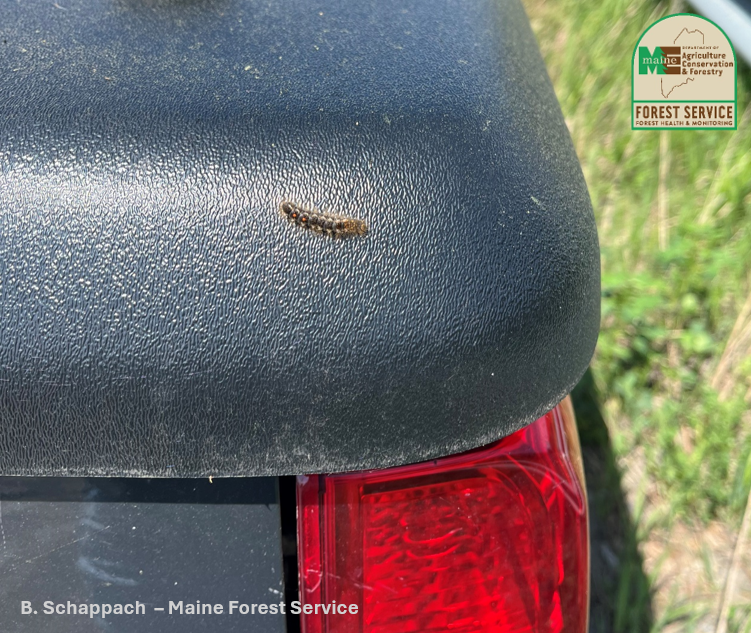
Some diseased caterpillars have been spotted...
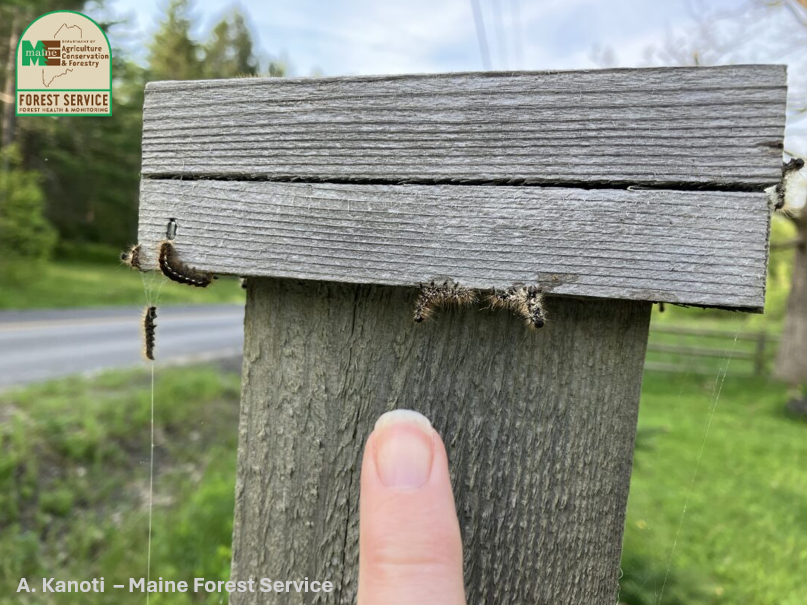
This week, we observed diseased browntail caterpillars at some of our monitoring sites. Moderate amounts of rain along with dryer spells this spring may have helped the growth of the fungal pathogens that cause browntail caterpillar mortality. Because browntail caterpillars are often found in groups, once the caterpillars die, the pathogens from the fungus or virus can be spread to other nearby caterpillars. Although we are seeing a few diseased caterpillars, it should not be assumed this will lead to a widespread die-off of browntail caterpillars. More typically, the fungus or virus may be able to spread in localized areas, like the population on a tree or a cluster of trees.
Some signs of pathogens may be:
- White or yellow fungal spores on caterpillars (Fungus)
- Caterpillars hanging onto branches with just their rear prolegs (leg-like extensions of the exoskeleton) (Fungus)
- Liquid expulsion of the caterpillar guts (often the caterpillar rests in an upside-down "V" shape) (Virus)
- Swollen, puffy caterpillars (Virus or Fungus)
- Dead caterpillars (Virus or Fungus)
We welcome any reports from the public of diseased caterpillars. Please include a photo or two in your report so we may confirm pathogen presence.
FAQ: Is it too late to prune the winter webs out of my fruit trees?
Yes, pruning this late into the spring season is stressful for the tree and not as effective at removing browntail. Further, browntail are becoming large and are not returning to their winter webs as often; meaning that even if you remove the winter webs, the browntail will still be found crawling around and eating leaves in the tree.
Populations of browntail moth in small fruit and ornamental trees are often readily managed using web clipping during winter. If you see defoliation from browntail in these situations, consider checking these trees for new winter webs beginning next fall. Then, remove and destroy all webs within reach by the end of next March. Many communities offer pole-pruners for loan, and browntail management can be an effort that brings neighbors together in winter
FAQ: Should I have my trees treated with pesticides to kill browntail caterpillars in late May?
The ideal time to treat your trees is from mid-April to early May, while the caterpillars are still small. That way, the trees still have most of their leaves and the caterpillars haven't shed as many toxic hairs into the environment. In late May, the caterpillars are large and have already eaten many leaves and shed many hairs into the area. Dead caterpillars will still shed toxic hairs. Consider taking precautions to avoid the rash and keeping an eye on the trees for new winter webs this fall. If the webs cannot be pruned, consider pesticide treatment at a more impactful time; mid-April to early May next year for more effective results.
Sign up for our Conditions Report to stay up to date on other insect and disease topics!
More Browntail Moth News Updates +
Close -
Events
- No events currently scheduled.
2023 Browntail Moth Awareness Month Webinar
Browntail Moth Mitigation Fund
The application period has now closed. The Division of Procurement Services Grant RFP/RFA page will have updates as soon as they are available. Please stay tuned for more updates.
General Information
 The browntail moth is an insect of forest and human health concern which was accidently introduced into Somerville, Massachusetts from Europe in 1897. By 1913, the insect had spread to all of the New England states and New Brunswick and Nova Scotia. Since that time, populations of this pest slowly decreased due to natural controls until the 1960's, when browntail moth was limited to Cape Cod and a few islands off the Maine coast in Casco Bay. Browntail moth populations are again building in Maine and are found in patches along the coast and up to 60 miles inland from the western Maine border to the New Brunswick border, with the greatest concentrations in mid-coastal Maine and the capital region.
The browntail moth is an insect of forest and human health concern which was accidently introduced into Somerville, Massachusetts from Europe in 1897. By 1913, the insect had spread to all of the New England states and New Brunswick and Nova Scotia. Since that time, populations of this pest slowly decreased due to natural controls until the 1960's, when browntail moth was limited to Cape Cod and a few islands off the Maine coast in Casco Bay. Browntail moth populations are again building in Maine and are found in patches along the coast and up to 60 miles inland from the western Maine border to the New Brunswick border, with the greatest concentrations in mid-coastal Maine and the capital region.
The larval stage (caterpillar) of this insect feeds on the foliage of hardwood trees and shrubs including: oak, shadbush, apple, cherry, beach plum, and rugosa rose. Larval feeding causes reduction of growth and occasional mortality of valued trees and shrubs. Learn More: How to Identify Maine’s Main Defoliating Caterpillars (YouTube) / Life Cycle of Browntail Moth (PDF)

While feeding damage may cause some concern, the primary impact on humans by browntail moth results from contact with poisonous hairs produced by the caterpillars. Microscopic, toxic hairs break off the caterpillars and can be airborne or settled on surfaces in browntail moth infested areas. Sensitive individuals who encounter the hairs may develop a skin rash similar to poison ivy and/or trouble breathing. Symptoms can last anywhere from a few hours to several weeks and can be severe in some individuals. Learn More: Maine CDC Browntail Moth Information
Management Techniques
Focus management on populations that will directly impact people, pets and livestock or pose a high risk of contributing to spread.
For Smaller Trees & Shrubs +
Browntail web removal: Webs in small trees and shrubs, safely within reach of the ground, and without hazards such as powerlines, can be removed between October and March. Browntail caterpillars emerge from their webs and begin feeding in mid-April, therefore webs removed after this time will not contain caterpillars and not be effective. Destroy webs once removed (burn, soak for an extended period in soapy water, or dispose of in trash). With permission, you can do this on properties you don’t own or manage. If there are hazards, or you need to leave the ground, this is work for a licensed arborist.
Use extreme caution if burning webs. Never burn unless the branches have been clipped off. This type of burning requires a burn permit. For more information, please visit www.maineburnpermit.com and check the daily forest fire danger report.
Browntail caterpillar treatment: Pesticide applications are most effective for browntail caterpillars when the pesticide product can take effect before late May. Treatments after that time are not recommended and are not part of an effective integrated approach to management (or IPM strategy). Since caterpillars are already wandering to new locations, targeted applications are not possible. Further, pesticide applications at this time of year are more likely to impact other living species in your trees, including pollinators and native insects, without effectively reducing the impacts from browntail. At this time, there are many shed caterpillar skins and toxic hairs that have already built up in the environment. To have more effective control of browntail, plan to target the next generation of caterpillars by scouting out new winter webs this winter to determine which trees you may want to treat next spring
Applications must be consistent with the label directions. Consider hiring a licensed pesticide applicator. In most years, treatment should be effective (caterpillars killed) before late May. Later treatments do little to reduce both hairs in the environment and damage to hosts.
If you are managing browntail moth using pesticides within 250 feet of the mean high tide mark adjacent to coastal waters and extending upriver or upstream to the first bridge, additional rules apply.
If you are unlicensed, do not use this approach on properties that are not yours or are open to the public.
Close -
For Webs in Taller Trees +
Hire professional help to treat webs out of reach or near hazards on the property you own or manage. Line up help during fall or winter.
Licensed Professional Arborists can remove BTM webs in larger trees and shrubs (October to March).
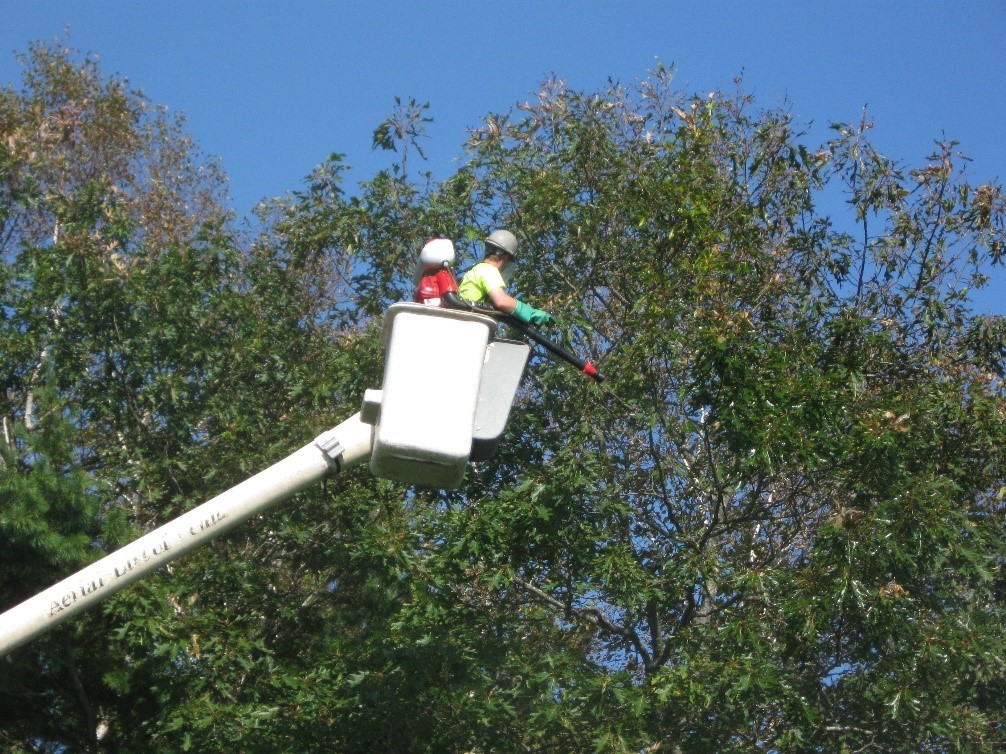
Unmanned Aerial Vehicle (UAV) Operators with an FAA Remote Pilot License may provide services using UAVs with attachments that physically remove webs.There is no requirement that these operators have knowledge of tree care. As in working with any professional, confirm your prospective contractor is adequately insured and qualified to provide the service.
- Licensed Pesticide Applicators willing to treat Browntail Moth, Hemlock Woolly adelgid and/or Other Pests
- Licensed Drone Operators (PDF)
- Arborists willing to PRUNE browntail webs in the winter (PDF)
For large trees, there are very limited insecticidal products (PDF) that are readily available to and applied by unlicensed individuals and that can legally be applied to target trees and life stages of browntail moth.** In trees where the caterpillars' hairs cause a nuisance and where it is not practical to remove the webs, Licensed Pesticide Applicators may be able to use insecticides during the growing season to manage BTM.
**Acecaps are not registered for use in Maine because the label does not meet federal standards for pesticide labeling. It is therefore not legal to use Acecaps. The Maine Board of Pesticides Control has provided support to the manufacturer to explain what needs to be changed to come into compliance and encouraged the manufacturer to work with EPA to bring their label up to standards. If we become aware of a change in status, we will update this message. You can check the current registration status by entering the product name in this database.**
Close -
Where is Browntail Moth in Maine?
Maine Forest Service conducts surveys for browntail moth from small planes and from moving trucks. These are broad-scale surveys that do not completely cover the impacted area. You can get a broad idea of where browntail moth is in Maine from our interactive map, just updated with 2023 winter web surveys. To understand what browntail moth is up to in a specific area, take a look at host plants for webs and signs of caterpillar activity.
Browntail Moth Interactive Map
Citizen Science Survey Protocol
Aerial Detection Survey Maps +
- 2022 Browntail Moth Aerial Detection Survey (PDF)
- 2021 Browntail Moth Damage Survey (with 2020-2021 Winter Web Survey data) (PDF)
- 2020 Browntail Moth Aerial Detection Survey (PDF)
- 2019 Browntail Moth Aerial Detection Survey (PDF)
Close -
Winter Web Survey Maps +
- 2023 Browntail Moth Winter Web Moth Survey (PDF)
- 2022 Browntail Moth Winter Web Moth Survey (PDF)
- 2021 Browntail Moth Winter Web Moth Survey (PDF)
- 2020 Browntail Moth Winter Web Moth Survey (PDF)
- Maine Browntail Moth Roadside Population Assessment: Winter 2018 (PDF)
Close -
For Towns and Organizations

Focus management on populations that will directly impact people, pets and livestock or pose a high risk of contributing to spread.
- Management Overview for Towns and Organizations (‘Municipal Battle Book’)
- Frequently Asked Questions
- An interactive map with past survey data has been updated with 2023 winter web survey data
- Browntail Moth Videos
Hire professional help to treat webs out of reach or near hazards on the property you own or manage. Line up help during fall or winter.
- Licensed Pesticide Applicators willing to treat Browntail Moth, Hemlock Woolly adelgid and/or Other Pests
- Arborists willing to PRUNE browntail webs in the winter (PDF | 340MB)
Social Media Toolkit +
#KnockOutBrowntail Business Challenge +
Research
Entomologists with the Maine Forest Service in the Department of Agriculture, Conservation and Forestry (DACF) have teamed up with the University of Maine to track the spread and investigate the causes of the outbreak and evaluate management strategies for this daunting pest.
- Evaluation of Biorational Insecticides for Management of Euproctis chrysorrhoea (Lepidoptera: Erebidae) | Journal of Economic Entomology | Oxford Academic (oup.com)
- Karla Boyd, Francis Drummond,Charlene Donahue, and Eleanor Groden; 2021: Factors Influencing the Population Fluctuations of Euproctis chrysorrhoea (Lepidoptera: Erebidae) in Maine (PDF | 693 KB)
- Karla Boyd’s 2020 thesis: "The Relative Abundance and Diversity of Parasitoids of the Browntail Moth (Euproctis chrysorrhoea L.) and Factors that Influence Their Population Dynamics"
- 2020 Summary of Research at the University of Maine (PDF | 1.49 MB), 2022 Update (PDF | 722 KB)
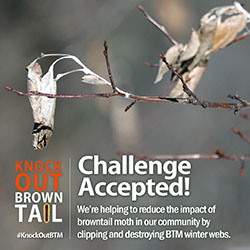
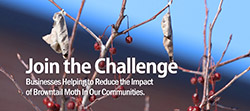
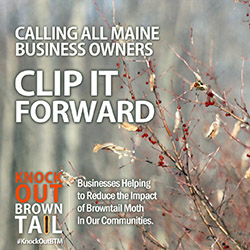
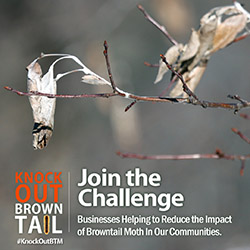
Click the images below for larger shareable graphics perfect for use on social media or Download All Graphics
Got questions about browntail moth? 211 is there to answer them.
Know your enemy and your friends. #KnockOutBTM, not silkmoths.
Image credits: DACF except promethea larva BOMONA user Zelenaks, promethea adult BOMANA user JRTindall
Learn how you can #KnockOutBTM and reduce the itch at www.maine.gov/dacf/knockoutbtm.
“browntail” in brown font
Learn how you can #KnockOutBTM and reduce the itch at www.maine.gov/dacf/knockoutbtm.
“browntail” in white font
Knock out browntail banner logo
“browntail” in brown font
Knock out browntail banner logo
“browntail” in white font
Knock out browntail stacked logo without URL
“browntail” in brown font
Facebook-ready image.
Learn how to safely remove and destroy browntail moth winter webs from the Maine Department of Agriculture, Conservation and Forestry at www.maine.gov/dacf/knockoutbtm #KnockOutBTM
To avoid encounters with the fuzzy caterpillars, remove and destroy browntail moth webs by April. Learn how from the Maine Department of Agriculture, Conservation and Forestry at www.maine.gov/dacf/knockoutbtm #KnockOutBTM
Close -